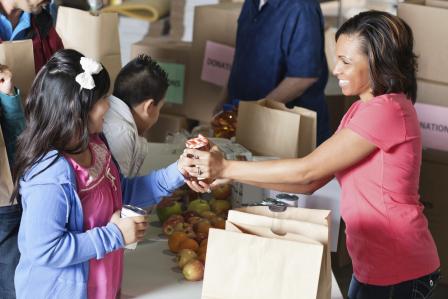Donating Food
By redirecting unspoiled food from landfill to our neighbors in need, individuals can support their local communities and reduce environmental impact. Non-perishable and unspoiled perishable food can be donated. Donated food can also include leftovers from events and surplus food inventory.
On this page:
Where to Donate
- Food Pantries
- Food pantries, food banks and food rescue programs are available across the country to collect food and redistribute it to those in need.
- Food Banks
- Food banks are community-based, professional organizations that collect food from a variety of sources and save the food in warehouses. The food bank then distributes the food to hungry families and individuals through a variety of emergency food assistance agencies, such as soup kitchens, youth or senior centers, shelters and pantries. Most food banks tend to collect less perishable foods such as canned goods because they can be stored for a longer time.
- Food Rescue Programs
- Food rescue programs take excess perishable and prepared food and distribute it to agencies and charities that serve hungry people such as soup kitchens, youth or senior centers, shelters and pantries. Many of these agencies visit the food bank each week to select fresh produce and packaged products for their meal programs or food pantries. Many also take direct donations from stores, restaurants, cafeterias, and individuals with surplus food to share. Remember to contact your local food pantry, food bank or food rescue operation to find out what items they accept. Also, food banks will often pick up donations free of charge.
Ideas for Increasing Food Donations in Your Community
- Leverage your existing relationships with food banks and kitchens to donate food after events.
- Enlist groups that meet within your facilities to assist in collection or distribution of donated food.

- Reach out to your local grocers, restaurants, venues and/or schools to suggest that they could donate wholesome food that will be wasted.
- Create a schedule for pick-up of donated food on a weekly, biweekly or monthly basis.
- Use donated food to feed the hungry or elderly of your community or for events held at your facility.
- Create a schedule of deliveries to shelters and food banks for donated food that cannot be used in your facility.
Food Donation Resources
Disclaimer: These sites are listed for informational purposes only. US EPA does not endorse any of these entities nor their services. Contact Us to suggest any additional links. The following links exit the siteExit
- Federal Bill Emerson Good Samaritan Act of 1996 encourages individuals or businesses to donate food to nonprofits by minimizing liability.
- Feeding America Food Bank Locator
- Food Rescue volunteer to collect unused food from restaurants and grocers to supply local food banks.
- Food Donation Connectionprovides useful information on food safety. FDC assists food service companies with putting their surplus food to good use.
